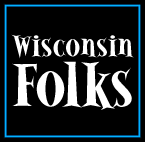|
Home | Search | The Artists | Teaching | Hiring | About This Site | Contact Us |
||
|
Pommersche Tanzdeel
Pommersche Tanzdeel Freistadt’s Art Form |
Pomeranian Dance, Music and Song There are so many things to watch and hear when you attend a dance performance! You can focus on the colors and designs of the dancers’ outfits. You can notice how the dancers move together as a group. You can listen to the music and feel its lively beat. Pommersche Tanzdeel Freistadt’s performing art lures peoples’ eyes and ears to many things. The dancing, the music, and the dress of PTF are the three components of their art form. Read on to learn more!
PTF has three performance groups arranged by age. Each one has a German name. Where would you fit if you were a member of PTF? Which groups would your family members fit into if they were members?
All of the groups dance for audiences, but the Jugend/Erwachsenen group performs the most frequently. Each group has its own director. The director choreographs. Craig Tews is the director for Erwachsenen. Craig has a big job to do when he choreographs. He must decide how many dancers will perform the dance, where they will move in relation to each other, and what moves will help the dance to look beautiful. He doesn’t create new steps for the old dances, but he arranges the patterns in new ways. PTF also reenacts Pomeranian weddings, harvest scenes, and fishing scenes from the 1700s and 1800s. These are called suites. When the dancers act out a scene, the songs’ lyrics tell what the dancers are doing and thinking.
The musical component of PTF is the ensemble that plays while the dancers dance. They are called Pommersche Späldeel Freistadt. You already know what two of the words in that name mean. Can you guess what Späldeel means? It means play. The music ensemble plays for the dancers and also separately. PTF’s president, Liesl Thomas, directs the musical ensemble. The musicians in Pommersche Späldeel Freistadt play the accordion, flute, piccolo, recorder, violin, bass violin, trumpet,
harmonica, guitar, and mandolin. What are they wearing?
The members of Pommersche Tanzdeel Freistadt and Pommersche Spaldeel Freistadt wear Trachten. What is a Tracht? Tracht is a German word. It doesn’t have an exact translation in English, but means something like “dress code.” If someone wears a particular Tracht, it identifies the wearer as part of a specific community or group. PTF dancers wear replicas of Pomeranian Trachten that Pomeranian people wore in the 17th century. The Pomeranian community in Freistadt, Wisconsin has documentation of four Trachten: 1) Mönchguter Fischer, 2) Pyritzer Weizacker, 3) Belbucker, and 4) Jamunder. They refer to different parts of Pomerania.
PTF dancers wear Trachten for performances in front of large audiences. They sing Pomeranian folk songs in them and
perform their ancestors’ folk dances in them. Traditions change and rearrange Long ago in Europe, people did folk dancing in their villages for fun and celebration. It was a way to take a break after working long and hard. Most of the people in the village would dance, not just tdancers. The villagers danced to please themselves, not to perform for others. They danced in their normal clothes, not in special costumes. PTF has kept some of those traditions of their ancestors’ folk dancing and have changed others. PTF strives to be historically accurate. They read books and speak with dancers in Germany about Pomeranian folk dancing. They look at drawings that show the kind of clothes that Pomeranians wore during certain time periods. They want their performances to show how their ancestors actually dressed, danced, and made music. Even though their dances are historically accurate, PTF’s dances are different from their ancestors’ in a few ways. PTF dancers don’t wear their normal clothes; they wear Trachten from centuries ago. They mainly perform for audiences, not just with each other. Not all the people in Freistadt know the dances, only a small group of dancers do. The dances are different today because the context is different, even if the movements, music and costumes are the same. |
For Educators: |
|
“(We) try to maintain the folk music and folk dancing of our ancestors, our Pomeranian ancestors.” – Norman Boehlke |
||
|
Home | Search | The Artists | Teaching | Hiring | About This Site | Contact Us |
||


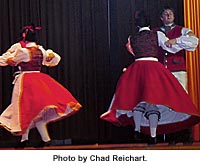 Dance and Song
Dance and Song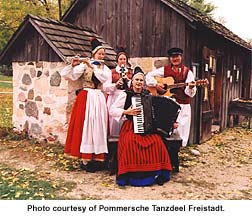
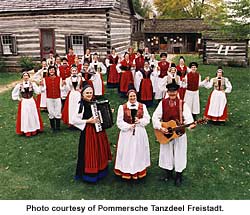
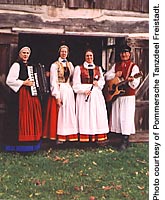 The red skirt with the white apron is the Belbuck Tracht. The group chose
to replicate the Belbuck Tracht because most of the settlers of Freistadt came from the Belbuck area of Pomerania. The black skirt with the red apron is the Mönchguter
Fischertracht. The
group thought this Tracht was colorful and unique. That is why they chose to replicate it.
The red skirt with the white apron is the Belbuck Tracht. The group chose
to replicate the Belbuck Tracht because most of the settlers of Freistadt came from the Belbuck area of Pomerania. The black skirt with the red apron is the Mönchguter
Fischertracht. The
group thought this Tracht was colorful and unique. That is why they chose to replicate it.